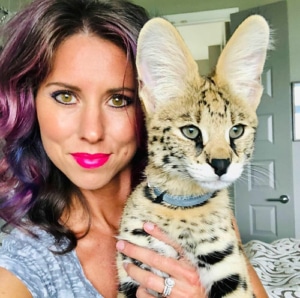Why are Savannah Cats so expensive?

Why Are Savannahs So Expensive?$$$
Establishing a quality breeding program there is a large financial investment required up front. Plus the proper care of all the cats on a daily basis takes a lot of time and patients and money. In addition to the cost upfront, the Higher percentage Savannahs (F1 )are rare and very difficult to produce. It takes many years and a lot of luck to mate a Serval with a domesticated cat. Only a few breeders worldwide have had success.
Servals are extremely picky and won’t just breed any cat you put with him. It often takes a few years of trying a particular female over multiple heat cycles before he might finally decide to breed her. That’s the second hurtle. The first one is getting both the serval and the female to get along / like each other. Many times the girls are afraid of the servals size and often times the serval doesn’t like way a girl looks or behaves and he just ignores her. So after months and even years of trying a female he finally does the deed. That’s the second hurdle.
3rd hurdle is she compatible? So many females can’t carry for f1. Probably only around 30% can do the job. Meaning she finally gets bred by the serval and doesn’t get pregnant, or does get pregnant and then 1/2 way through the pregnancy she absorbs them, delivers too early and babies don’t make it. So you grow these cats out till they are mature enough to breed, then try them over and over again for another year or two only for her to fail at producing f1. It costs a ton of money to properly feed and care for the cat’s daily.
So you’re thinking well maybe she’s not fertile. But that’s Hardly ever the case. Cuz after trying so long with my serval I’ll pair the female with bst male and sure enough she’ll have 5-6 kittens not problem. There’s just an incompatibility issue with the Serval to domestic.
If mating occurs there are still lots of risks. Because of the gestation difference between the Serval and domestic (about 10-15 day difference) all F1s are born premature. Some are too weak to survive and need 24 hr care by the breeder to ensure survival. Also their litters are generally small, averaging from 1-3 per litter.
When it comes to producing the F2, there are similar challenges. You take a large F1 female and breed her with an F5, F6, or F7 male (remember the males are sterile until the F5 generation).
The first challenge is size difference, large female to small male and the act of breeding can be difficult. Another challenge is the f1 female in heat can be very moody and aggressive toward the male and not allow him to mate her. There are some males that are too scared of an F1 and wont try. Once breeding occurs, an F2 litter is small, averaging 1-3 kittens per litter. Theres countless hours the breeder spends to ensure health, safety and socializing of these kittens.

